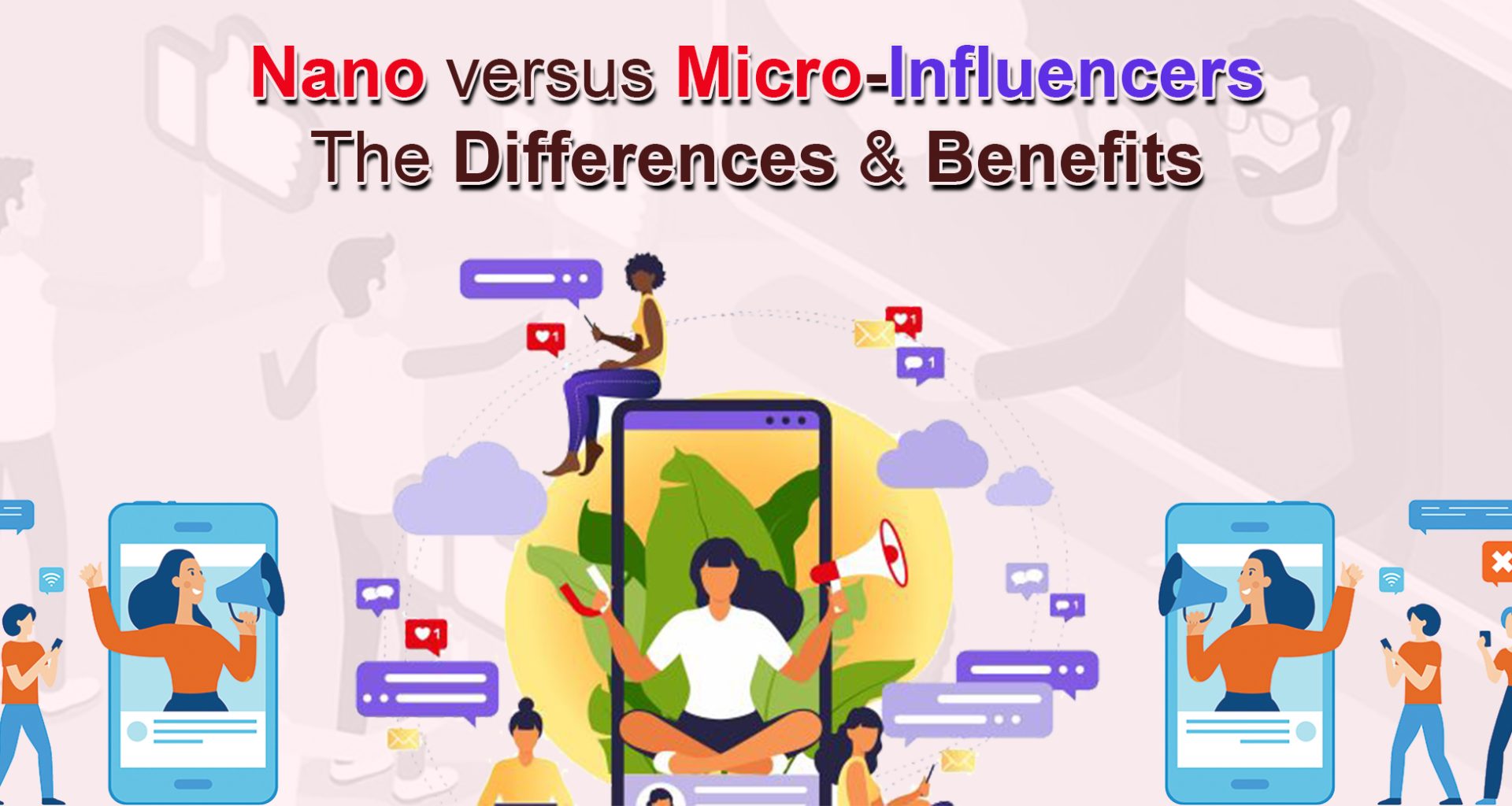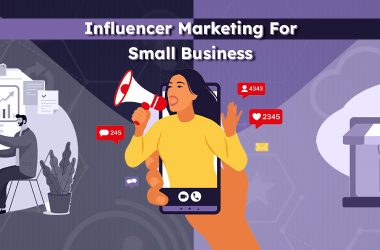In today’s digital era, influencer marketing has become a strong instrument for companies to engage with their target audience and promote their products or services. Within the area of influencer marketing, two groups have attracted substantial attention: nano-influencers and micro-influencers. These individuals, with their modest but highly engaged following, provide particular benefits for organizations attempting to cultivate a genuine and effective online presence.
This blog covers the distinctions and advantages of nano and micro-influencers, offering light on their qualities, audience reach, engagement levels, influence on purchase choices, content development, and affordability. By knowing these nuances, companies can make educated choices when it comes to choosing the best influencers for their campaigns, refining their marketing tactics, and maximizing the advantages received from influencer partnerships.
In the following portions, we will delve into the domain of nano and micro-influencers, accentuating their distinct capabilities and providing tactics for efficiently coping with them. Let’s discuss the power of authenticity, the amplification of reach, and the crucial variables to consider when picking influencers. Finally, we will analyze techniques to optimize influencer campaigns and capitalize on the advantages that nano and micro-influencers may offer to a brand’s marketing efforts.
Nano-Influencers: The Power of Authenticity
Nano-influencers are persons who have a minuscule but highly engaged following on social media sites. They often have less than 10,000 followers, but what sets them unique is their ability to communicate honestly with their audience. Nano-influencers are frequently ordinary individuals who have created a dedicated following around specialized expertise or passion.
Small yet Mighty: Nano-Influencers’ Restricted Audience
Nano-influencers may have a diminished audience compared to macro-influencers, but their adherents are highly focused and share a genuine interest in the material they provide. These limited audiences are impassioned about the particular subjects or businesses that nano-influencers concentrate on. For example, a nano-influencer who specializes in vegan cuisine may have a committed following of persons interested in plant-based meals and lifestyle.
The significance of authenticity and trust in nano-influencer campaigns
Authenticity is the cornerstone of nano-influencer initiatives. Nano-influencers generally have a profound tie with their followers, predicated on trust and genuine connections. Their material seems genuine and honest, making it simpler for their audience to trust their advice and thoughts. As a consequence, when a nano-influencer supports a product or business, their followers are more likely to see it as a genuine recommendation.
Benefits of Collaborating with Nano-Influencers
● High engagement rates owing to profound ties with followers One of the primary advantages of engaging with nano-influencers is their high engagement rates. Since nano-influencers have a lesser following, they are able to interact more intimately with their audience. They have the time and ability to reply to comments, address inquiries, and establish a sense of community. This kind of involvement leads to higher engagement rates on their postings, with followers actively liking, remarking, and sharing their material.
● Cost-effectiveness for reduced marketing budgets
Working with nano-influencers is a cost-effective method, particularly for firms with minimal marketing expenditures. Nano-influencers typically offer affordable prices or may even be open to product partnerships in return for publicity. This makes it more feasible for smaller firms or businesses to employ influencer marketing as part of their entire marketing plan.
● Genuine and accessible material that resonates with the intended audience
Nano-influencers are noted for their ability to generate content that engages profoundly with their audience. They understand the interests, preferences, and pain points of their followers, enabling them to generate material that seems authentic and relatable. When they promote a product or brand, it doesn’t come off as contrived or unduly promotional. Instead, it seems like a personal endorsement from a trusted acquaintance, which has greater weight and Impact.
In conclusion, nano-influencers have a unique power anchored on sincerity. Their smaller, specialist audiences enable them to establish strong connections, resulting in high engagement rates. Moreover, their cost-effectiveness and ability to generate pertinent content make them an appealing alternative for marketers attempting to connect with their target audience in a real and meaningful manner. Collaborating with nano-influencers may be a wonderful complement to any influencer marketing plan, allowing companies to leverage the power of authenticity for maximal effect.
Micro-Influencers: Amplifying Reach and Influence
Micro-influencers are persons that have a little larger but still targeted following on social media platforms. They often have a few thousand to tens of thousands of followers. Like nano-influencers, micro-influencers generally concentrate on specialized niches and appeal to a certain demographic.
Expanding Reach: Micro-influencers’ Broader but Still Focused Audience
Micro-influencers give a wider reach compared to nano-influencers, attributable to their larger follower network. While they may not have the vast reach of macro-influencers, their audience is nonetheless highly focused. This enables companies to reach a larger population of prospective clients who are interested in their specialty or sector.
The Impact of micro-influencers on consumer purchase selections
Micro-influencers have a considerable effect on consumer purchase choices. Their adherents believe their advice and views because they have established a strong relationship and reputation within their particular group. Micro-influencers are perceived as reputable sources of information and product evaluations, making their recommendations more persuasive.
Benefits of Collaborating with Micro-influencers
● Increased reach and exposure for brands
Collaborating with micro-influencers helps firms reach a larger audience and enhance their exposure. The larger following count of micro-influencers provides for greater exposure and brand recognition. By delving into their audience, companies may broaden their reach and attract prospective consumers.
● Stronger connection with the intended audience via common interests
Micro-influencers generally have shared interests with their followers. This common passion generates a deeper relationship and connection between the influencer, the brand, and the audience. When micro-influencers recommend a product or service that corresponds with their audience’s interests, it seems more genuine and engages with their followers on a deeper level.
● Greater potential for enhancing conversions and sales
Due to their trusted connection with their audience, micro-influencers have a larger potential for enhancing conversions and purchases. Their followers are more inclined to take action based on their suggestions, resulting in greater engagement, website traffic, and, eventually, enhanced conversion rates for the company.
Collaborating with micro-influencers gives companies the potential to magnify their reach, develop a closer connection with their target audience, and increase conversions and sales. The larger but still focused audience of micro-influencers, along with their significant position in purchase choices, makes them excellent companions for firms attempting to maximize their influencer marketing efforts.
Nano versus Micro-Influencers: The Key Differences
When contrasting nano and micro-influencers, some significant distinctions emerge, which might affect a brand’s influencer marketing approach. Let’s analyze these differences:
1. Audience quantity and reach
Nano-influencers have a limited audience compared to micro-influencers. Nano-influencers often have a few thousand followers, whereas micro-influencers may have tens of thousands or even hundreds of thousands of followers. This disparity in audience size influences the total reach and potential visibility that a business might acquire via partnership.
2. Engagement levels and relationship with followers
Nano-influencers experience higher engagement rates compared to micro-influencers. Due to their limited following, nano-influencers may establish tighter interactions with their audience. This profound connection leads to more meaningful conversations, improved levels of engagement, and enhanced trust. Micro-influencers, while they have a greater following, may have somewhat reduced engagement rates as their audience size rises.
3. Scope of effect and Impact on purchase selections
Micro-influencers often have a greater spectrum of influence compared to nano-influencers. With a broader following, micro-influencers have the ability to reach more individuals and expose a company to a wider spectrum of customers. They may have a stronger effect on purchase selections attributable to their potential to influence a larger number of followers. On the other side, nano influencers’ influence is confined to their specific audience, resulting in a more targeted effect.
4. Content creation and brand partnerships
Nano-influencers are renowned for their genuine and pertinent content that interacts well with their audience. They often focus intensely on their topic and provide information that is highly specialized and appropriate for their followers’ interests. With a larger following, micro-influencers may cover a wider range of topics and produce content that is more appealing to a larger audience. Additionally, their contracts with firms could include a wider range of industries and products.
5. Costs and affordability for brands
Due to their decreased audience size, nano-influencers often demand affordable rates compared to micro-influencers. This cost-effectiveness makes cooperating with nano-influencers a realistic choice for firms with modest marketing budgets. On the other side, micro-influencers, with their greater following and wider reach, may need a higher investment from marketers. Brands need to investigate their budget and the possible return on investment when choosing between nano and micro-influencer collaborations.
Understanding these key distinctions is vital for marketers to make educated choices when choosing influencers for their campaigns. Factors such as campaign objectives, target audience, intended reach, and financial limits will play a vital role in evaluating whether nano or micro-influencers are the greatest matches for a brand’s unique requirements.
Choosing the Right Influencers for Your Campaign
1. Defining campaign objectives and target audience:
Prior to employing influencers for your campaign, it’s crucial to explicitly delineate your marketing objectives. Decide what you want to achieve, such as brand awareness, higher sales, or audience targeting. Determine who your target market is and get familiar with their likes, interests, and inclinations.
2. Evaluating audience alignment with influencer profiles:
Evaluate how well an influencer’s audience corresponds with your target demographic. Look at the demographics, interests, and engagement of their followers. Ensure that there is a natural relationship between the influencer’s audience and your brand’s target market. A matched audience boosts the possibility of your message interacting with the proper persons.
3. Considering engagement metrics and genuineness:
Engagement metrics play a significant role in analyzing an influencer’s performance. Look at the number of likes, remarks, and shares their posts get. Higher engagement suggests an engaged and involved audience. Additionally, emphasize genuineness. Authenticity promotes trust and credibility, so analyze the influencer’s ability to communicate with their followers genuinely.
4. Analyzing prior partnerships and brand match:
Review an influencer’s prior partnerships to determine their suit for your company. Assess if they have cooperated with analogous businesses or within your sector. Look at the caliber of the material provided and the audience’s reaction. Ensure that the influencer’s values align with your brand’s beliefs to ensure brand consistency.
5. Weighing the budget and cost-effectiveness:
Consider your budget and the cost-effectiveness of interacting with various influencers. Nano-influencers are frequently more cost-effective, whereas micro-influencers may demand a larger expenditure. Evaluate the possible return on investment (ROI) and the value that each influencer may provide to your campaign. Balance your budget with the influencer’s reach, engagement, and total effect.
By following these methods, you may discover the influencers that most correspond with your marketing objectives, target audience, and budget. Remember that identifying the appropriate influencers is a critical component of a successful influencer marketing campaign. Take the time to study, evaluate, and consider the aspects enumerated above to make educated judgments and enhance the efficacy of your campaign.
Maximizing the Benefits: Strategies for Working with Nano and Micro-Influencers
To make the most of your influencer relationships, employ the following strategies:
1. Establishing precise campaign objectives and expectations
To optimize the advantages of collaborating with influencers, it is vital to define explicit campaign objectives and expectations from the beginning. Clearly explain what you expect to accomplish with the influencer cooperation, whether it’s greater brand recognition, product promotion, or bolstering sales. Communicate these objectives to the influencers, ensuring that everyone is on the same page and working towards the same aims.
2. Nurturing ties with influencers for long-term partnerships
Building firm connections with influencers may lead to beneficial long-term collaborations. Invest time and effort into learning their requirements, preferences, and content development process. Engage in frank and frequent contact, giving feedback and support. By developing these connections, you may establish trust, loyalty, and mutual respect, resulting in more effective and potent partnerships.
3. Encouraging creative freedom while connecting with company ideals
Give influencers the latitude to convey their ideas and demonstrate their distinct panache. Encourage them to develop content that engages with their audience while being loyal to your brand’s values and message. Provide defined standards and brand message, but provide the opportunity for creative interpretation. Balancing creative license with brand alignment ensures that the influencer’s material remains real and genuine while also promoting your business successfully.
4. Leveraging user-generated content and audience involvement
Encourage influencers to include their audience in your campaign via user-generated content (UGC) and audience involvement. UGC not only promotes engagement but also enhances the connection between the influencer, your brand, and their followers. Encourage influencers to organize competitions and challenges or seek feedback from their audience. This not only promotes interaction but also fosters a feeling of community and inclusion around your brand.
5. Tracking and assessing campaign performance for optimization
Implement monitoring methods to monitor the effectiveness of your influencer marketing. Track critical KPIs like as engagement rates, reach, conversions, and sales. Analyze the data to discover areas for enhancement and optimization. This information can help you comprehend what works and what doesn’t, enabling you to adapt your plans for future campaigns. Regularly monitor the Impact of each influencer cooperation to make educated choices and manage resources efficiently.
By applying these tactics, you may optimize the advantages of working with nano and micro-influencers. Clear objectives and expectations, building relationships, combining creative license with brand alignment, using UGC, and measuring campaign effectiveness can help you unleash the full potential of influencer marketing. These techniques not only enhance the performance of your current initiatives but also construct the framework for long-term collaborations with influencers in the future.
Suggestion: 10 Best Digital Marketing Strategies For Startups In 2023
Conclusion
In conclusion, nano and micro-influencers offer distinct benefits to influencer marketing initiatives. Nano-influencers flourish in authenticity, high engagement rates, and cost-effectiveness, owing to their personal connections with their followers and specific emphasis. On the other side, micro-influencers provide enhanced reach, closer relationships with the target demographic, and a higher possibility for generating conversions and sales due to their larger but still focused following.
When recruiting influencers, organizations must evaluate their marketing objectives, target audience, and budget. It’s vital to link the influencer’s audience with the brand’s target market and verify that the selected influencer can genuinely reflect the brand’s values. Both nano and micro-influencers play a vital role in connecting companies with their target audience on a more intimate level, bolstering trust and engagement.
In the future, influencer marketing is anticipated to continue increasing as a strong instrument for companies to reach and communicate with their audience. The emergence of nano and micro-influencers underscores the relevance of real and pertinent material in today’s digital ecosystem. Brands that emphasize creating real connections, choosing influencers meticulously, and generating pertinent and authentic content will be best positioned to prosper in influencer marketing and engage with their target audience in meaningful ways.








